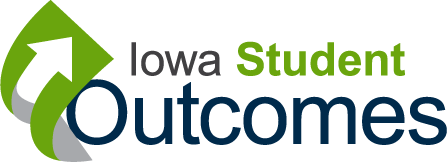Iowa Community Colleges
Community College Profiles
Community college profiles are compiled as a set of major statistics and outcomes for each academic year. They consist of Institution profile in two sections, credit and noncredit; Performance profile, presenting major performance measures; and workforce-bound program outcomes with number of completions and median wages in employment past program completions. The charts and data are interactive and can be downloaded for distribution in a static format or for further processing.
Credit Program Outcomes
The Iowa Community Colleges Statewide report documents the educational and employment outcomes of students completing community college certificate, diploma, and associate degree programs, including the number of awards, time-to-degree, retention, migration, transfer to four-year institutions, employment and wages, career clusters, and career pathways. The report for the latest cohort can be downloaded here. Data tables for the latest cohort can be downloaded here. Access to the previous cohorts reports and data tables can be found on this page under the Credit Program Outcomes section.
Noncredit Program Outcomes
This groundbreaking Iowa Community Colleges: Noncredit Career and Technical Education (CTE) Employment Outcomes Report, provides information about community college noncredit program completion, student retention, in– and out-of-state migration, employment and wages, career cluster to industry mapping, and in-demand occupational analysis for those who completed community college CTE noncredit programs. The report for the latest cohort can be downloaded here. Data tables for the latest cohort can be downloaded here. Access to the previous cohorts' reports and data tables can be found on this page under the Noncredit Program Outcomes section.
Credit and Noncredit Enrollments
This comprehensive compilation of Iowa community colleges enrollments data for the past 24 years includes credit and noncredit numbers of enrolled students, credit hours for credit enrollments, contact hours for noncredit enrollments, comparative charts for attempted, completed and successfully completed courses and credit hours in a variety of formats: line, bar, funnel charts and accompanying data tables. Enrollments and hours presented by college and state-wide.
Joint Enrollment Outcomes
The Iowa Department of Education collects information on joint enrollment from Iowa's 15 community colleges. Jointly enrolled students are high school students enrolled in community college credit coursework. The report here is based on the 2011 Iowa high school graduating class; high school students were followed to postsecondary education enrollments and completions for eight years following high school graduation. The student cohort was split into two groups: those who experienced joint (dual) enrollment (JE) and those who did not enroll in joint (dual) enrollment options (NJE). The data provide insight into the education outcomes by those two categories of students and demonstrate the impact of joint enrollment on students' post-high school pathways, which are reflected in the rates of postsecondary enrollments, persistence in postsecondary education, rates and time to graduation from postsecondary institutions, potential cost savings for students and their families and earned credit. All data provided for jointly enrolled students are in comparison to students who did not participate in joint enrollment.
Corrections Outcomes
This information included in this report is a statewide attempt to analyze data, establish a baseline and report the post-release outcomes of incarcerated students. Education, employment and wage outcomes were collected for individuals released from prisons in Iowa who participated in training programs. In the report here, two levels of education are explored: secondary, for high school equivalency diplomas, and postsecondary education in Iowa's community colleges.
CTE Postsecondary Credential Outcomes
The Strengthening Career and Technical Education for the 21st Century Act, commonly referred to as Perkins V, was signed into law on July 31, 2018. This federal law reauthorizes the Carl D. Perkins Career and Technical Education Act of 2006, which provides almost $1.2 billion in federal support for career and technical education (CTE) programs in all 50 states and U.S. territories, including support for integrated career pathway programs for students. Iowa receives nearly $12 million annually in federal funds, divided between secondary and postsecondary CTE programs delivered through public school districts and community colleges.
Congress made accountability for results a central focus of Perkins V, setting out new performance requirements for States and local programs. These requirements were established to assess the effectiveness of the State in achieving statewide progress in career and technical education and to optimize the return on investment of Federal funds in career and technical education. Perkins Collaborative Resource Network.
Under Perkins V, states are required to report annually on core indicators of performance for both secondary and postsecondary. States are also required to report disaggregated data on the performance of students by race, ethnicity, gender and special population categories.
The "Iowa Perkins V & CTE Summary" dashboards cover information on secondary and community college performance accountability defined in the Federal Perkins V Act, as well as enrollment, both statewide and by district. The data boxes above highlight some of the key outcome measures contained within these reports.
Completer/Leaver Comparative Analysis
A statewide analysis of the impact of accumulated credit hours, program of study, and the industry of employment on success in the workforce for Iowa community college students who completed or left their community college program within academic year 2015-2016 (AY 15-16). The report for AY 2015-2016 cohort can be downloaded from here. Data tables for the report for AY 2016-2017 cohort can be downloaded from here.
Guided Pathways
A national, research driven, whole-college redesign model designed to help all students explore, choose, plan and complete programs aligned with their career and education goals efficiently and affordably. Colleges implement Guided Pathways reforms to improve student completion rates, close achievement gaps and increase enrollments in an increasingly competitive environment. More information can be found here.








